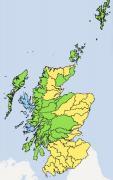Indicative River and Coastal Flood Map (Scotland)
15th October 2006
The Scottish Environment Protection Agency (SEPA) is distributing, under licence, initial copies of this map to organisations, including the Scottish Executive, local authorities and emergency services. The map gives an indication of the areas in Scotland potentially at risk of flooding from either rivers or the sea, or both.
The map has been developed to provide a national picture of flood risk to be used as a strategic flood management tool, to help planning authorities and others, to identify where further consideration of flood risk may or may not be needed for proposed development, and to raise public awareness. It supports Scottish Planning Policy (SPP) 7 Planning and Flooding. This information will also be made available for the public to view via the SEPA website, from 1 November 2006.
The information relating to flood risk from rivers has been created using sophisticated modelling techniques to estimate, and route, flood volumes of river water across a representation of Scotland's landscape. The information relating to the flood risk from the sea was created by projecting estimated extreme sea levels onto the approximation of Scotland's coastal landscape. Both these techniques then provide an indication of where flooding is likely to occur.
The development of improved flood risk information for Scotland was made possible by the production (by Intermap) of a digital terrain model (DTM) of the whole of Scotland. The DTM provides a more accurate representation of the physical geography (or landscape) of Scotland than has been previously available. Intermap developed a DTM for Wales and England earlier than for Scotland, and so the Environment Agency has already been able to develop and publish its flood map.
Dr. Chris Fuller, SEPA project manager said: "The Indicative River and Coastal Flood Map (Scotland) provides an indication of the areas of Scotland estimated to be at risk of flooding. The map can be used to inform planning considerations and generally
raise awareness of flooding probabilities, therefore helping people to be more prepared for flooding. This is an important milestone in the project, and we will now focus on the technical work required to make the maps available for the public to view via SEPA web pages."
Related Businesses
Related Articles
Water scarcity report from SEPA
The river catchments of the Nith, Dee (Galloway), Cree, Doon, Irvine and Ayr and the Clyde have been raised to Alert. The river catchments of the Shin, Naver, Conon, Spey, Deveron, Ythan, Don (Aberdeenshire), Dee (Aberdeenshire), Esk, Firth of Tay, Firth of Forth, Almond, Tyne (Lothian), Tweed, Esk (Dumfriesshire), Annan and Thurso remain at Alert.
Working together for the North Highland water environment
Protecting and enhancing the natural waters of the North Highland area is a huge task involving many organisations and communities, and Scotland's environment watchdog is urging all those with an interest to get involved. The Scottish Environment Protection Agency (SEPA) is asking interested local communities and businesses to read the draft River basin management plans (RBMP) and Local area management plans (AMP) and feed back whether they think the plans are comprehensive enough, how they can help to achieve the aims of the plans, and how we can all work together to achieve them.New environmental regulations needn't be costly
In the current economic climate it is essential businesses are prepared for new regulations, as failure to comply could lead to increased costs. NetRegs (www.netregs.gov.uk) is a free UK website offering environmental guidance for businesses and is delivered in partnership with the Scottish Environment Protection Agency (SEPA).Scotland's recycling rate continues to rise
Scotland's recycling and composting rate continues to make steady progress. Figures released today (Friday 13 February), by the Scottish Environment Protection Agency (SEPA), show that Scotland's annual recycling and composting rate rose to 32.9% for the year October 2007 to September 2008.New approach to improving the future health of Scotland's water
Scotland's environment watchdog has found that 57% of Scotland's water is in good condition, or better. This provides an excellent basis for our future livelihoods, economy and recreation.NORTH-EAST FARMER FINED FOR RIVER POLLUTION
A north-east farmer was fined �2000 for allowing diesel to enter surface water drains and into a tributary of the River Ythan causing pollution of the river. Mr Roger Glennie from the Hillhead of Ardo Farm, Methlick, Ellon pled guilty today (21 January 2009) to a contravention of legislation designed to protect the water environment.SEPA cuts red tape in waste regulations
The Scottish Environment Protection Agency (SEPA) has announced further steps to reduce bureaucracy, while still ensuring high levels of environmental protection. Changes have been put in place to how SEPA enforces three sets of regulations; the Producer Responsibility (Packaging Waste) Regulations, the Waste Electrical and Electronic Equipment Regulations (WEEE) and the Trans Frontier Shipment Regulations (TFS).Climate Change Plan for SEPA published
With the Climate Change Scotland Bill now in parliament, it is important that everyone starts thinking how they will contribute to the ambitious world leading targets set out in the Bill. As Scotland's environment watchdog, the Scottish Environment Protection Agency (SEPA) has a key role in addressing climate change and has today (19 December) published its climate change plan for SEPA.SEPA reveals 10-point plan to support economic activity
The Scottish Environment Protection Agency (SEPA) has developed, with Government, a 10-point Plan to support economic activity during the current difficulties. The aim is to help the economy whilst also protecting the environment and the health and well being of communities across Scotland.SEPA urges everyone to have a safe and happy Bonfire Night
Now that the evenings are getting darker, and colder, many people are starting to think about Autumnal celebrations like Hallowe'en and Bonfire Night. While huddling round a blazing bonfire is an important part of the celebrations, and a good way to keep warm, the Scottish Environment Protection Agency (SEPA) is reminding everyone that careful consideration needs to be given to what goes on any pyres.
